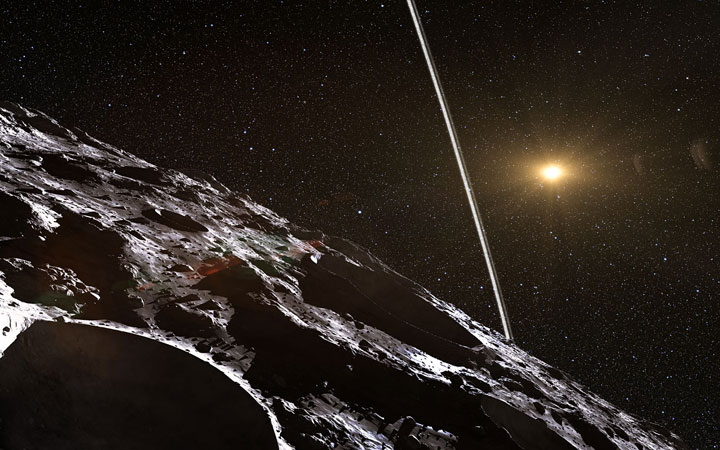TORONTO – The universe is marvellous, and it never ceases to surprise astronomers.

On Wednesday, however, astronomers revealed a major surprise very close to home.
Last June, using telescopes from seven different locations around the world, scientists prepared to view the asteroid Chariklo pass in front of a star, called an occultation. During this process, a star blinks out as a planet or asteroid passes in front of it.
Except just before Chariklo’s occultation — and just after — the star blinked.
This makes Chariklo a pretty cool object: it’s the first known asteroid — and the smallest body in our solar system — to possess a ring system.
The findings were published in the March 27 edition of the journal Nature.
READ MORE: Water discovered on asteroid points to habitable exoplanets
“We weren’t looking for a ring and didn’t think small bodies like Chariklo had them at all, so the discovery — and the amazing amount of detail we saw in the system — came as a complete surprise,” said Felipe Braga-Ribas of the Observatório Nacional/MCTI, Rio de Janeiro, lead author on the new paper.
Chariklo is part of a group called Centaurs, objects that exist in our solar system in unstable orbits. They can share similar characteristics to both asteroids and comets. Chariklo is one of the largest of these types of objects and lies in an orbit between Saturn and Uranus in the outer solar system.
Further analysis revealed that the 250 kilometre-wide asteroid has two distinct systems, one seven kilometres wide, the other three kilometres wide. The rings are separated by a gap of nine kilometres.
READ MORE: Astronomers surprised to find passing asteroid has a moon
Ring systems are thought to be the result of unformed moons. In the case of Saturn — the most beautiful example in our solar system of a ringed body — the rings are made up of billions of small particles from the size of a grain of sand to a those as large as mountains. They are highly influenced by the moons around it.
But many people don’t realize that Jupiter, Uranus and Neptune all have their own ring systems.
Jupiter’s ring system was discovered by NASA’s Voyager 1 spacecraft in 1979, and was a surprise to scientists. They are made up of small, dark particles which make them hard to see unless they are backlit from the sun. Later, the Galileo spacecraft, which orbited Jupiter from 1995 to 2003, determined that the rings were formed by meteoroid impacts on some of Jupiter’s nearby moons.
Uranus also has faint rings. But Uranus is also special because it has the odd distinction of being the solar system’s only planet that is tilted sideways. Interestingly, in 1977, Uranus’s rings were also found in the same manner as Chariklo’s.
Neptune, the farthest planet in our solar system, at 4.5 billion kilometres from the sun, and a gas giant like Jupiter, Saturn, and Uranus, also possesses rings, and surprise — they were discovered by observing an occultation.

In the case of Chariklo, astronomers believe that it was formed after the asteroid collided with another object.
Only time — perhaps a lot of time — will tell if these chunks of rock gather to form a moon. If they do, it could help scientists confirm the formation of our own moon and those in the rest of the solar system, leading to a better understanding of the formation of bodies in our solar system.





Comments